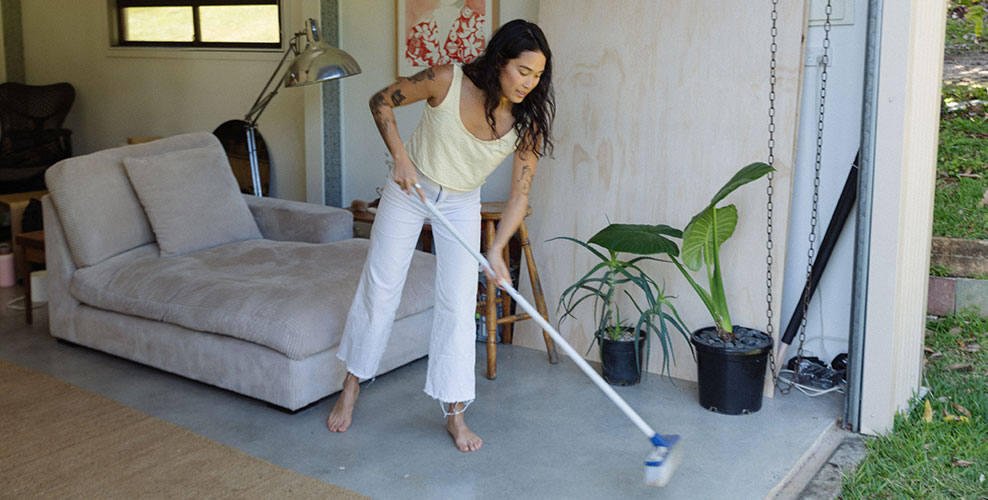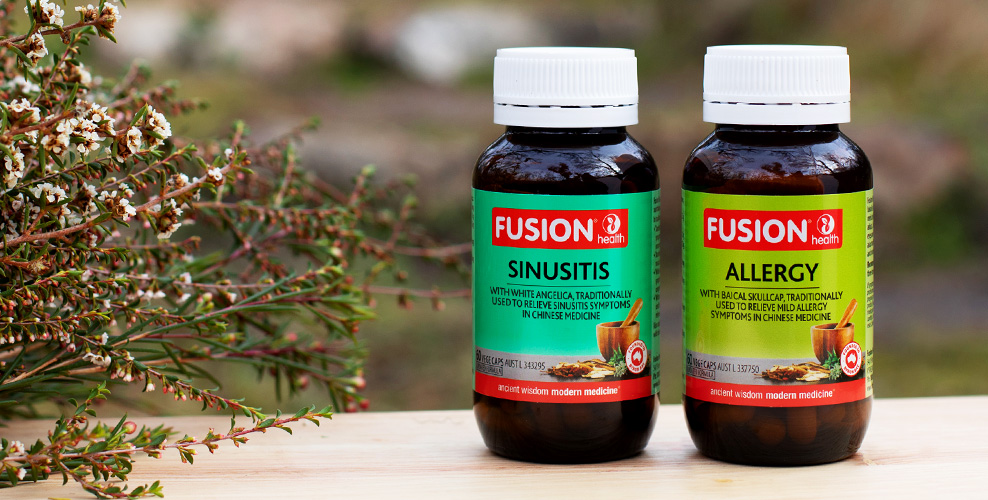How to prevent and reduce hay fever and sinusitis symptoms at home
For many hay fever and sinusitis sufferers, springtime is when their symptoms peak, while others experience symptoms year-round.[1] The great news is there's a variety of ways you can get symptomatic relief. So, whether your struggles are year-round or seasonal, read on for some tips that could save you a small fortune on tissues and eye drops.
Quick overview
- Sinusitis and hay fever symptoms come from different origins. However, people who experience hay fever can also develop symptoms of sinusitis like nasal congestion[2]
- The way you clean your home can make a big difference to the recurrence and symptoms of hay fever and sinusitis
- Tweaks to diet and lifestyle can help to bring about relief for both hay fever and sinusitis symptoms

What is hay fever?
Hay fever, or allergic rhinitis, is an allergic reaction to environmental allergens. The most typical triggers of hay fever are pollen, dust, dust mites and mould spores. Dander (skin cells) from pets can also cause some sufferers grief. Particles such as chlorine and detergents in polluted air may be a cause of symptoms in some hay fever sufferers. Hay fever symptoms include red, itchy eyes and a blocked, runny and itchy nose.[3]
Hay fever season
Spring is the peak season for hay fever due to the increase in pollen production by flowering plants and tress. In the earlier part of summer, certain grasses may also cause hay fever symptoms.[3]
Some people will suffer with hay fever symptoms year-round - this is referred to as perennial allergic rhinitis. The same symptoms as springtime hay fever occur, but the intensity and duration of symptoms may differ.[3]
Hay fever vs common colds
Hay fever and common colds have some similar symptoms, but because their causes and treatment options are different, it’s important to be able to spot the difference[4]:
- Hay fever, being an allergic reaction, activates a different part of the immune system to common colds which are a viral infection
- A common cold will likely be accompanied by a runny nose with thick yellow or green discharge, while a runny nose from hay fever is usually clear and watery
- If you’re experiencing a common cold you will likely have a sore throat, whereas if you have hay fever symptoms, one of these defining features is itchy eyes and nose
What are sinusitis symptoms?
Sinusitis symptoms are most commonly caused by a sinus inflammation – sometimes associated with the common cold. The common cold can cause swelling and inflammation in the nasal passages or sinus cavities in the skull, which causes pain and tenderness in the area.[2]
Sinusitis symptoms include:[2]
- Nasal or post-nasal drip
- Sinus pain
- Nasal congestion
- Excess nasal mucus
What triggers sinusitis symptoms?
As well as illness (such as a common cold), there are some other potential triggers for sinusitis. Some people who experience hay fever can also develop symptoms of sinusitis like nasal congestion.[2]

How to prevent and relieve hay fever and sinusitis symptoms at home
Although you can’t control the outside environment, you can control your home environment. If your living space is harbouring the usual suspects – dust, dust mites, animal dander and pollen, it’s time for that spring clean.
Here are our ten top tips for home cleaning to keep those allergens at bay:
- Use a damp, microfibre cloth to pick up dust instead of a traditional duster that just moves the particles around
- Be the owner (and regular user) of a vacuum cleaner with a high efficiency particulate air (HEPA) filter, which removes even the tiniest of allergens
- Wash sheets every 3-7 days, particularly if you suffer from allergies and asthma [5]
- Hang anything that can’t be washed regularly, such as rugs or duvets, outside in the sunshine often. The sun is one of the best antibacterial and dust mite-killing resources around. Be sure to give these items a thorough shake before bringing them back inside as they may collect pollen
- Avoid dangerous or harmful cleaning chemicals, as these can be a trigger for those prone to allergies. There’s so many great eco and allergy friendly cleaning products out there - head to your local health food store for more advice on choosing products
- Avoid clutter build-up on desks or bedside tables where dust can quickly collect
- Throw damp towels and bathmats directly into the washing machine to avoid mould that may grow when they’re left sitting for too long
- Be a ‘leave your shoes at the door’ kind of household. Tracking dirt and pollen into the house after all your cleaning efforts is not ideal!
- Hardwood floors and tiles are better for allergy sufferers, but they still need to be mopped regularly. For the best results, use boiling water and an eco-friendly floor cleaner
- If you have any pets that shed, give them a regular wash and then brush them outside
Diet and lifestyle tips for easing symptoms of hay fever and sinusitis
Diet and lifestyle can also play a big part in alleviating and even recurrence of hay fever and sinusitis symptoms:
- Vitamin D has recently been discovered to play a role in hay fever as it helps to support the immune system.[6] Make sure to keep up for vitamin D levels by getting some regular, safe sun exposure and vitamin D-rich foods in your diet
- Boost your exercise efforts. A survey conducted by the National Pollen and Aerobiology Research Unit in the UK concluded that exercise helps to reduce hay fever symptoms in sufferers. Exercise indoors if the air quality is poor or pollen count outside is high [7]
- Avoid foods that you know you are allergic or intolerant too as these can increase the load on your immune system
- Steer clear of mucus-forming foods such as dairy, fried foods and high sugar/refined foods
- The symptoms of hay fever are triggered by histamine, a compound that your body releases when it encounters an allergen. Some people find relief with a low histamine diet which reduces the overall histamine load on the body. High histamine foods to avoid include aged cheese, wine, cured or fermented foods, tomatoes, eggplants, spinach, citrus and avocado.[8] Instead, enjoy low histamine foods like fresh fruit and vegetables fruit (except for those listed above), fresh fish, red meat and poultry (not leftover, cured or canned), rice, oats, quinoa and coconut products
- If you suffer from seasonal allergies, take steps ahead of time to increase your body’s resistance to allergens. Ensure your sleep is adequate and good quality, use stress-relieving techniques and eat plenty of protein, fresh fruit and vegetables
How Chinese medicine can help relieve hay fever and sinusitis symptoms
There’s lots of ways Chinese medicine can help to reduce the symptoms of hayfever and sinusitis. One of these is to rug up and keep your chest and neck covered on cold, windy days. Protecting these areas against wind is thought to help reduce sinusitis and hay fever symptoms according to traditional Chinese medicine (TCM).
In a review of 13 studies looking at alleviating symptoms of allergic rhinitis, acupuncture was revealed to reduce the common symptoms of hay fever.[9] This is believed to be due to the ability of acupuncture to positively influence the immune system.
At home acupressure can also be applied for relief of the symptoms of hay fever and sinusitis. Using your thumbs and fingertips, massage the tender areas around the sinus, including forehead and tops of eyebrows. This helps to move qi (vital energy) that might be blocked, bringing relief for sinus pain, nasal congestion and headaches.
Several herbs are also used in TCM to relieve symptoms of hay fever and sinusitis.
Consider a supplement such as Fusion Allergy with baical skullcap, which is traditionally used to relieve symptoms of hay fever, including red, itchy eyes and a runny, blocked or itchy nose in TCM.
For relief from sinusitis symptoms try Fusion Sinusitis, which includes xanthium, traditionally taken to relieve the symptoms of sinusitis, including runny nose, nasal congestion and pain in Chinese medicine. Plus, white angelica, traditionally used in TCM to relieve the nasal congestion associated with sinusitis.
Hay fever and sinusitis symptoms can be uncomfortable. Switching up your cleaning routine and adding in some key herbs, along with small diet and lifestyle tweaks, can help you breathe a congestion-free sigh of relief.
References:
- Asthma Australia. Last updated September 2020 and accessed July 2021 from https://asthma.org.au/about-asthma/triggers/hay-fever/
- Australasian Society of Clinical Immunology and Allergy. Last updated May 2019 and accessed July 2021 from https://www.allergy.org.au/patients/allergic-rhinitis-hay-fever-and-sinusitis/sinusitis-and-allergy
- Hechtman, L. Clinical Naturopathic Medicine 2nd Ed, 2019. Chatswood, NSW: Churchill Livingstone Elsevier.
- Medical Xpress. Last updated October 2018, accessed August 2021 from https://medicalxpress.com/news/2018-10-difference-hay-fever-common-cold.html
- Sleep Foundation. Last updated October 2020, accessed July 2021 from https://www.sleepfoundation.org/bedding-information/how-often-should-you-wash-your-sheets
- Tian HQ, et al. Asia Pac Allergy 2017;7(2):65-73.
- NHS Forum Health Centre. Accessed July 2021 from https://www.forumhealthcentre.nhs.uk/your-health/five-tips-to-reduce-your-hay-fever-symptoms
- House of Wellness. Last updated November 2018, accessed July 2021 from https://www.houseofwellness.com.au/health/conditions/follow-low-histamine-diet
- Feng S. Am J Rhinol Allergy 2015;29(1):57-62.






















